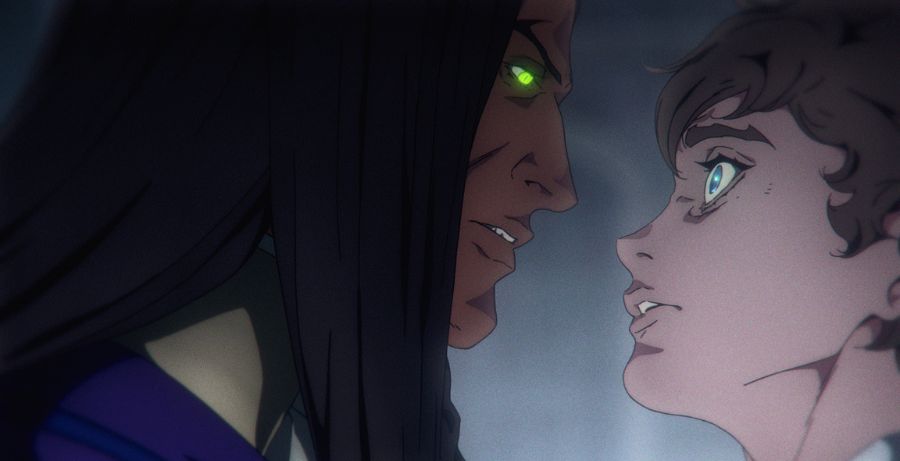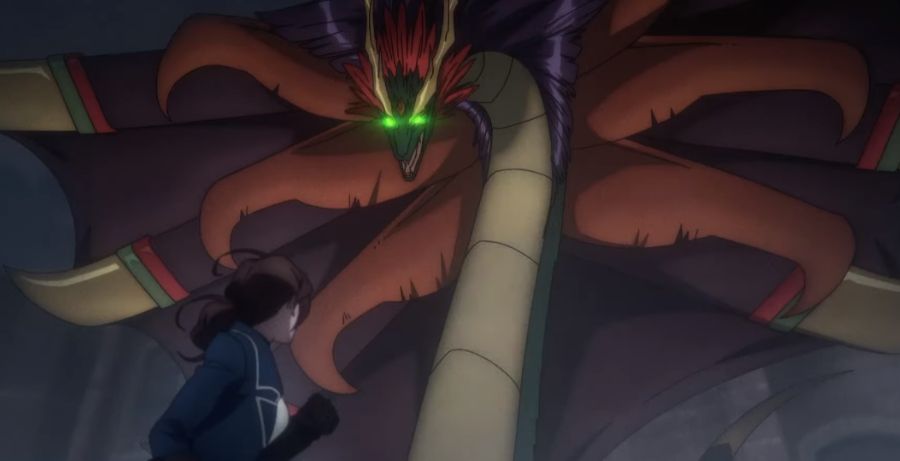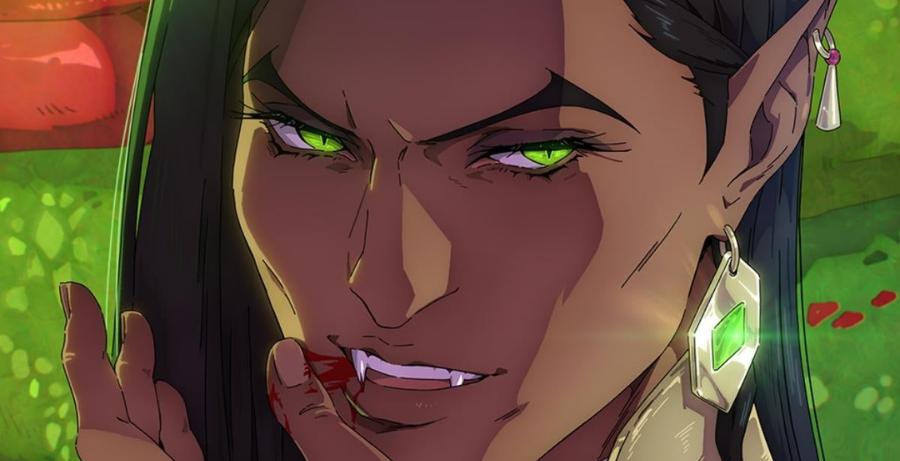One of the strongest points of the original Castlevania series wasn’t just what it was able to do with secondary and tertiary characters, taking them from footnotes to dynamic story drivers, but that it was able to do that with antagonists. While the heroes of the series were stellar, the writing team stretched their narrative muscles by giving the audience villains adapted from bosses in the Castlevania franchise and making them more than one note. In fact, between Carmilla and Isaac, audiences got a masterclass in giving antagonists reasons without apologetics. Olrox is that character in Castlevania: Nocturne.
As we dive into who Olrox is and why he carries so much power in the story, here is your obligatory spoiler warning for Castlevania: Nocturne Season 1.
Is Olrox in the Castlevania video games?
Yes, and absolutely in the way that we see Olrox in Castlevania: Nocturne. A boss in Castlevania: Symphony of the Night, Olrox rules the upper part of Dracula’s castle and wears an armored suit, with his primary power being fire. He is known as Count Olrox, Count Orlok, or Orurokku, depending on who you’re talking to. And that’s it. Appearing dressed in purple and a true form that looks like an anthropomorphic reptile. Like the original series, the boss battle that Olrox appears in is filled with religious imagery, taking place in front of tall stained-glass windows and his weakness is a holy elemental attack, making vials of holy water your friend. But that reliance on religion in his origin isn’t where we find him in this incarnation of this enemy for the sequel series.
Much of who Olrox is outside of his boss battle is filled in by the Kabuchi no Tsuisoukyoku novel where he is described as an oddity among vampires. Rather than revel in destruction or sadistic practices, Olrox’s motivations are mostly fueled by curiosity and thrills. That curiosity is embodied by the fact that he attempted to conquer both Chaos and humans solely out of hypothesizing that by controlling the hearts of humans that form Chaos, it would disappear. It’s clear that the team at Powerhouse took Kabuchi no Tsuisoukyoku into account because Olrox in the series is unlike anyone we see in this series or have seen before. He may be a vampire lord but he’s something else altogether too.
Who is Olrox in Castlevania: Nocturne?

Olrox is the opening villain of Castlevania: Nocturne, killing Richter Belmont’s mother, Julia Belmont (Sophie Skelton), moments into the start of the series. Played by Zahn McClarnon, Olrox is beautiful but has a level of intimidation that is palpable, crystalized in his final threat to Richter. There is something more sinister in allowing the child of the woman you just killed to live and letting your shadow infect his life from that moment on, a specter of death on the horizon.
Like other main villain or antagonist in the original Castlevania series, Olrox is more than meets the murderous green serpent’s eyes. Over the course of the series, audiences get small glimpses into who he is, and the love he had in his life, which, by his account, has only occurred once in his 250 years of being a vampire. With background elements shared in the intimate moments with Mizrak, his lover, this season, the writers have chosen to give Olrox a twinge of vulnerability.
In two conversations, Olrox lays his position toward the Vampire Messiah, Erzsébet Bathory, on the table. He is here to commune with the Messiah, not worship her. He is here to speak with her, not to be told what to do. While the vampire aristocracy is ready to bow to the bloody goddess, Olrox is not. He doesn’t believe in fanatical loyalty and despises arrogance, and that’s constantly clear even as he seeks his vengeance. He takes time explaining how his one and only love was a proud Mohican man who fought with the Americans in the Revolution, despite knowing that these white men would never grant him freedom. Olrox, in his love, was moved by the call for revolution, but that ended when Julia Belmont killed his lover, who he had turned into a vampire.
Despite feeling like he fills the role of the main villain, like in the original series, Olrox’s motivations are similar to Dracula’s: It’s love. Olrox’s suit may be one of the ways that you know who he is, but the depth of his character is one informed by who he loves and protects.
Despite claiming not to understand the need for rebellion, Olrox embodies it and, as such, the core message of the series. When asked to subject himself to Erzsébet, he refuses twice until finally bowing to her. Only the animators have illustrated that bow by panning in close to his face, his eyes looking up and directly at the Messiah, not to the ground subjecting to her power. A vampire of Native American descent, Olrox’s personality is one that understands his role in the world. Being a master manipulator has helped him in this endeavor. He can read people and other vampires beautifully enough to map out his own course.

Olrox is a vampire who is heavily informed by his understanding of what other vampires do and have done. Similarly to Annette, he has witnessed their cruelty and subjectation firsthand as he notes to Mizrak in another exchange after their intimacy in Olrox’s quarters. Olrox’s background is identifiable by three things this season. The first is when he transforms into a winged serpent, a Mesoamerican deity. The second is when Drolta calls him the Aztec. And the third is when he talks about watching vampires come with white colonizers onto his shore and decimate his people and their land. Olrox, our Aztec vampire with an aristocratic persona now sporting an iconic purple Victorian suit, he wants to become the murderer of Richter Belmont, but he bows to no one.
His identity as an indigenous man isn’t something that leaves him now that he is a powerful vampire. On the contrary, it’s why he moves alone and why he will not subjugate his power to someone else. This is where he shifts from villain of the series to an antagonist moved by his ideals and vengeance, not the wonton violence or belief that vampires are superior.
Even his choice to kill Richter’s mother wasn’t just from a need to take out a vampire hunter or cause pain. Instead, he is moved by his grief and pain, like others in the series. He was seeking revenge for losing the man he loved, and in that way, Olrox becomes someone you can understand, like Dracula, who moved to end humanity because he lost his wife. Olrox is a man of emotion as much as he is a violent vampire. But don’t let it fool you, this isn’t a copy of Dracula, he has his own machinations.
With his turn to helping Richter (Edward Bluemel), Annette (Thuso Mbedu), and Maria (Pixie Davies) in the final episode of the season, Olrox stands to be a big influence on Castlevania Season 2. Even more so when you factor in that he went against his words to Mizrak and, through his actions, has shown his love for him.
Unlike the other vampires this season, Olrox is stalwart in his personal ideals and has a long memory of vampire history and oppression that adds a new flair to vampire society that we haven’t seen before. More importantly, we haven’t seen Olrox regret his power or his standing, only the way in which he has seen the world unfold. The design of this character is iconic, but his motivations and growth are perfect, he decieves us all into thinking he only cares about his own life’s safety, only to show just how much he loves those in the human world.
Listen to our interview with directors Sam & Adam Deats, and co-showrunner Kevin Kolde here, to hear more about Castlevania: Nocturne.
What are Orlox’s powers in Castlevania: Nocturne?

Orlox has got to be one of my favorite adaptations of a Castlevania boss across both Powerhouse Animation series. In Castlevania: Symphony of the Night, Orlox is wearing purple and what has been described as a suit of armor. In the series, Orlox wears a purple 18th-century nobleman outfit equipped with gold and green jewelry that highlights his bright green eyes.
In Castlevania: Nocturne, Orlox’s powers are brought wonderfully to the screen with quite a bit of faithfulness to what we see in the game. In fact, there are so many aspects of the original enemy alive in this iteration. First, he can fly, leaving silhouettes of himself behind faintly. This is exactly how we see him in the game, dodging your attacks with a purple outline of himself trailing behind him. Then there is his large attack in which he opens a black portal and summons blue skulls from it, a powerful barrage of fireballs, and a hellfire spell.
This attack is illustrated immediately within the series’ first seven minutes as he fights Julia Belmont. Orlox as a fighter is defined in his fullest in his fight with Julia, kicking off the series with a big bang and letting his influence stretch over the series without actually needing to see his full power again.

Finally, we see Orlox’s second form, which in the game is a giant reptile-like humanoid that spits fire and a light beam. While his first form is gorgeous, his lizard form’s skin is beautiful as well. In Castlevania: Nocturne, Orlox still transforms into a reptile, only this time it’s a serpent with wings, more specifically Quetzalcoatl, the Aztec deity of creation that existed to create humanity.
In the series, he uses lightning to trap Julia before finally taking his life. Larger than life, the rendering of his reptile form is gorgeous to behold, and the attention given in this adaptation of his powers in animation rivals anything we’ve ever seen. With Annette embodying the god Ogun, and the Vampire Messiah representing the lioness Sekhmet, the choice to make Olrox a god as well is striking. While some may believe he should have been an original character or that he feels like one, he’s set to play a much bigger role in Season 2 that goes beyond just bringing pieces of fidelity to the boss battle Konami brought us. Though watching Powerhouse animate more energy blasts, a huge beam of light, or adding a skelerang or two to the mix would be really cool.
Castlevania: Nocturne Season 2 can’t come soon enough, and that’s because, with his short amount of screen time, Olrox already has a significant presence in the series. This article clocks in at around 1200 words without this closing section, and that’s a testament to the layered design of his character that encompasses dialogue and visual storytelling. With so much more to give and with Mizrak on his side and the Vampire Messiah against him, Olrox can be one of the best characters the franchise has brought forth. Plus, you know you want him to meet Dracula’s son Alucard. If his journey so far in Castlevania: Nocturne is anything to judge him by, he will be.
Castlevania: Nocturne is streaming now, exclusively on Netflix.





